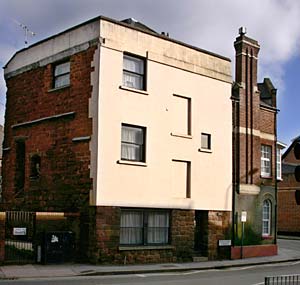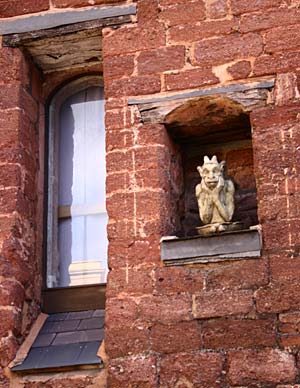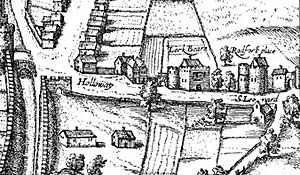
Great Larkbeare House or 38 Holloway Street
Page updated 5th October 2010
This house, also known as Great Larkbeare, was part of an original castellated 15th century house that can be found in the dip of Holloway Street on the corner of Roberts Road. It was a substantial house built out of Heavitree stone, and boasted a garderobe or lavatory, which emptied into the Larkbeare or Shutebrook that ran into the Exe.
The bridge on Holloway Street
The earliest reference to the site, on which the house stands, was in 1253 when Walter de Okestone granted Segar de Clist a garden without the Southgate in Carterne-street, by the brook next to Richard de Leverbere's (Larkebeare) land. The brook was the Larkbeare or Shutebrook which rises near St Anne's Chapel in St Sidwell's. The brook was culverted in 1843, in the period after the cholera outbreak of 1832, as it had become a heavily sewage polluted waterway.
The stream runs under the front left corner of the house (see photo right) and across Holloway Street. Archaeological evidence from the excavation of a GPO trench in 1979 found that the Shutebrook was originally bridged in the centre of Holloway Street – the bridge had a span of only 1.4 metres, reflecting the width of the small brook, but it had a carriageway 3.7 metres (12 ft) wide with half metre parapets on each side. The arched construction has six chamfered Gothic style ribs to span the brook. Further investigation suggested that the bridge is from the 13th century, and contemporary with the old Gervase bridge that crossed the Exe. The bridge along with the Victorian brick vaulted culvert, below, and an earlier stone lined culvert with flat roofing slabs that runs under the house remain. Although there is no sign of the mediaeval bridge as it is covered by the modern roadway, it was declared a scheduled ancient monument in 1981.
The house
Originally built for woollen merchants, it was inhabited by the Hull family in the 15th-century, and Sir Nicholas Smith, a Sheriff of the City in the 16th-century. An early reference to the house is on Hoghenbegh's map of 1587, where it is depicted with castellated walls, a round castellated tower and arched side entrance, all in front of a range of cultivated fields. In 1716, an advert appeared in the 'Exeter Post Boy' which said:
"A Tenement To Be Lett Being the Fore Part of Larkbeare House, without Southgate, Exon, containing a Kitchen with a little Room by, a Large Parlour and a Cellar, with a Chamber over the Cellar; also 5 Lodging Chambers with 3 Closets; likewise a Garden; being very fit for a Private Family or any one who chooseth to live without the limits of the City. You may inquire of Mr. Lavington at Larkbeare House, who is ready to treat with any Person about the same".
The Baring's woollen factory
It was let to tenants by its owner, a Mr Lavington. The house, along with 37 acres, was sold in 1737 to John Baring, of the Baring Bank family. Johann Baring was a German Lutheran from a family of wealthy cloth manufacturers who came to Exeter in 1717. In 1723 he was naturalized and married Elizabeth Vowler, the daughter of a tea and coffee wholesaler.
Baring's fortune was initially made as a woollen serge manufacturer and merchant, and he built a manufactory on the land next to the house. The house had "large press-shops, packing rooms, linhays, tenter-grounds, and all conveniences on the demesne for finishing woollen cloths." After Baring's death in 1748, his son, also John, purchased and moved into Mount Radford House in 1770, while his other son, Charles, remained in Larkbeare. John Jnr., leased a fulling mill in Exwick that would supply the Larkbeare manufactory with cloth. A third son, Francis Baring moved to London as a merchant, where he purchased materials for his brother's Exeter business and found new markets for their output. It was Francis who founded Baring Brothers, the merchant bank.
The manufactory at Larkbeare House survived into the early nineteenth-century but Exeter's woollen trade was no longer pre-eminent and was in fast decline. The Barings vacated the house in 1819 to let it to tenants, and disposed of the house in 1832 to a Mrs Hodge. The house started to deteriorate and in 1889 it was partly demolished when Roberts Road was developed and Holloway Street widened. It would seem that a Mr G Digginnes rescued and gave a "number of carvings in stone from the old Larkbeare House, lately demolished; and these it is hoped may some day be built into some portion of the Museum". (FP 1890) In 1770, John Baring Jnr., established the Devonshire Bank.
The secret tunnel
A few years later and a letter appeared in the Flying Post regarding a possible tunnel that existed between Larkbeare House and the Cathedral, with an open request for further information from local historians. In October 1900 the Flying Post printed "A subsidence of the roadway occurred in Holloway-street on Tuesday morning in an underground passage leading from Larkbeare House, which was demolished in 1890, to the Cathedral, and from thence to the Castle." No history of Exeter or the house that I have consulted has mentioned this tunnel and whether it was explored, and where did it really lead... ? It is of course possible that this tunnel was the conduit that carried the Shutebrook under the house.
In 1975 the remaining building was declared to be in a dangerous condition leading to it being listed in 1977. Exeter City Council stepped in to save the house, and with help from the Devon Historic Buildings Trust, the building was purchased for £1, against the wishes of its owners, the BP Oil Company, who wanted to demolish it. BP also owned the adjacent filling station, which has since closed. In their defence, BP made a donation to help with the cost of restoration.
The property really was in a very poor condition, and the front wall was in imminent danger of collapse due to the shaking it had to endure from the passing traffic. In 1979, major restoration work was done, creating an attractive two bedroom dwelling. Some of the rooms have oak coffered ceilings, original stonework and the whole has an oak-braced roof. It also has a stone figure probably B&Q, circa 1998, preserved in a niche on the side wall that can be easily observed as you pass the house. As a bonus, the figure is festooned with tinsel at Christmas.
There is a large, greystone house opposite the Elizabethan house, between Holloway Street and the river, also called Larkbeare House. It was purchased by the city in 1876 and is used as a judges residence and a centre for hosting conventions. The house, standing in its own grounds, surrounded by a 10ft high wall, has eight bedrooms and costs £4,100 a week (2004) to rent. The gardens contain the redundant Port Royal lime kilns which were fed with lime from ships docking on St Leonards Quay, just below. In 1850, the St Leonards Quay limeburner was listed as W H & W W Hooper.
Source: Discovering Exeter, St Leonard's by Gilbert Venn, the Exeter City Council history website, Trewman's Exeter Flying Post, 2000 Years in Exeter by W G Hoskins, Proceedings of the Devon Archaeological Society No 39 (1981), encyclopedia.com and research for the Exwick Paper Mill. Detail from map at Devon Library and Information Services
 The front of Larkbeare House.
The front of Larkbeare House.
 Detail
of the house including a modern inhabitant.
Detail
of the house including a modern inhabitant.
 Larkbeare
House on Hoghenbegh's map.
Larkbeare
House on Hoghenbegh's map.
│ Top of Page │